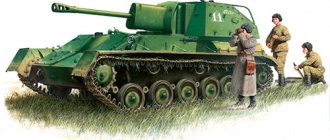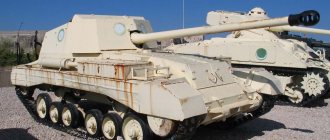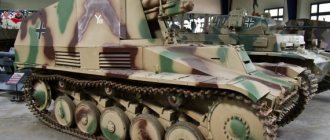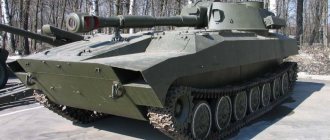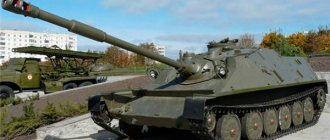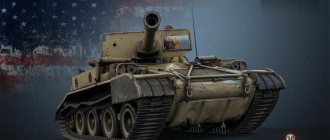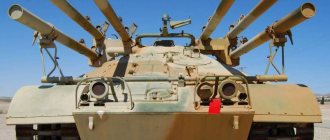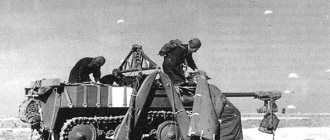Rate this post
The legendary Soviet heavy self-propelled artillery unit ISU-152 and its predecessor SU-152 played one of the key roles in the turning point of the Great Patriotic War. After all, it was these armored vehicles that were able to give a worthy rebuff to the powerful German Tiger and Panther tanks, leading the Soviet troops to victory in the Battle of Kursk. The soldiers of the Red Army boastfully called it “St. John’s wort,” and the Wehrmacht troops cautiously called this self-propelled gun “Dosenöffner,” which translated into Russian means nothing more than a can opener.
History of creation
By the end of 1942, the Soviet army was in dire need of a new self-propelled artillery unit. After all, as combat experience has shown, high-explosive fragmentation shells from 76-mm Soviet tank guns were not enough to support infantry offensive operations. The enemy built more and more powerful fortifications. And self-propelled howitzers often could not keep up with off-road conditions, becoming easy prey even for enemy infantry armed with small arms.
Accordingly, in 1943, a new self-propelled unit SU-152 was designed at the Chelyabinsk Tractor Plant No. 100. The chassis for the new product was borrowed from the KV tank, and instead of a rotating turret, an armored wheelhouse was installed, which housed the legendary 152 mm Soviet howitzer ML-20S with a barrel length of 29 calibers. The main projectile for this installation was the high-explosive fragmentation shell OF-540, which, if necessary, was supplemented by the armor-piercing BR-540.
Crew training
The crew consists of five people, there are two loaders, and the commander has a combined specialization with the radio operator. If you have new tankers, we’ll take a closer look at what skills to upgrade for the ISU-152K .
First of all, it is necessary to reduce the visibility of the car, so we download Camouflage. Then we’ll reset it to the commander on the Sixth Sense. At the second level, it is important to improve the stabilization of the gun with a combination of the Smooth Turret Rotation and Smooth Movement perks. At this time, the chargers are downloading Repair.
Having gained 2.5 skill levels, I recommend making a reset to select the Combat Brotherhood for all tankers. Next, at the expense of the commander, we increase the visibility: Radio interception + 10.5 meters and Eagle Eye + 7 meters. The gunner will need the Sniper to crit enemy vehicles more often. As an option, at level 5, take Master Weaponsmith if you often crit your gun when trying to tank. Or take Repair if you want to act more aggressively.
We take the Virtuoso and the Off-Road King to improve mobility. We give one of the loaders a Non-Contact Ammunition Rack to increase the module’s strength, and the second one a Desperate Ammo Rack to speed up reloading when the health margin is below 120 units. Then we take Repair as a charger again and, out of desperation, the Intuition skill.
Battle of Kursk
It was the SU-152 self-propelled artillery mount, on the basis of which its modernized version ISU-152 was later created, that repulsed the powerful German Tiger and Panther tanks in the Battle of Kursk. Initially, the tasks of this self-propelled gun were to support offensive infantry operations. But later it turned out that Soviet tanks, equipped with a 76-mm cannon, simply could not inflict significant damage on the new German “leviathans,” which had significantly increased their armor.
This is where the SU-152 was needed, the large-caliber projectile of which had colossal kinetic energy. After all, even without penetrating the armor of a German tank, a shell from this armored vehicle could easily disable a German tank and its crew, and the explosion of a high-explosive fragmentation shell near a German vehicle could neutralize its chassis and sights.
Accordingly, it was after the Battle of Kursk, where the SU-152 self-propelled artillery mount showed all its effectiveness, that they began to call it “St. John’s wort”. Soviet soldiers then joked that it was the SU-152 that served as a kind of “vaccination” for them against “Fear of Tigers.” And German officers enviously called the Soviet novelty a can opener (“Dosenöffner”), because it “opened” almost any German armor without any problems.
Advantages and disadvantages
After a detailed acquaintance with the tactical and technical parameters of the ISU-152K, we can highlight its strengths and weaknesses in order to briefly summarize the information listed above.
Advantages:
- large one-time damage;
- high armor penetration;
- strong gun mantlet;
As a bonus, I would add here the inner satisfaction when you destroy half the enemy’s HP, and those weak in ammo capacity (we say hello to Caernarvon) can be shot with 1 shot.
Flaws:
- poor accuracy;
- long mixing;
- uncomfortable UVN;
- poor agility;
- very low review.
Heavy self-propelled artillery unit ISU-152
Already in the summer of 1943, the SU-152 was modernized. The basis for the new self-propelled gun ISU-152 was the heavy Soviet IS tank. Soviet engineers managed to improve the armor of the new self-propelled gun to 90 millimeters. But in all other respects, this armored vehicle was completely similar to its predecessor.
Heavy self-propelled artillery Soviet regiments, which certainly included ISU-152 self-propelled guns, took an active part in many offensive operations in the last years of the Great Patriotic War. Supporting the offensive actions of infantry and tanks, ISU-152s targeted enemy firing points.
On January 15, 1945, in East Prussia, German troops launched a counterattack by Soviet units. The infantrymen were forced to retreat to the defensive positions of the self-propelled guns. And it was thanks to the firepower of the ISU-152 that the enemy counterattack was successfully repulsed.
The ISU-152 was no less effectively used in artillery preparations. Thus, during the Sandomierz-Silesian operation, 980 shells were fired from ISU-152 self-propelled guns, which destroyed two mortar batteries, eight guns and one enemy battalion, which included Wehrmacht soldiers and officers.
The ISU-152 had no equal in tank battles. An unsuccessful counterattack by Wehrmacht soldiers during the Berlin operation on April 19, 1945 led the Germans to significant losses in the form of 10 heavy tanks and more than 300 soldiers and officers.
According to Soviet veterans, a precise hit from an ISU-152 shell on a German heavy tank turned the latter’s turret into a pile of metal. Not only the Tigers and Panthers, but also the German modernized Sturmpanzer IV self-propelled guns could not resist the power of the Soviet heavy self-propelled artillery unit ISU-152. After all, at that time this Soviet technology simply had no equal!
SU-152 in the factory workshop, summer 1943.
The first example of the IS-152 artillery self-propelled gun (object 241) in the courtyard of plant No. 100.
Experimental self-propelled gun ISU-152-1 (object 246).
Experimental self-propelled gun ISU-152-2 (object 247).
Self-propelled gun ISU-152 being tested.
SU-152 in a firing position, 2nd Baltic Front, spring 1944.
ISU-152s are fighting, Karelian Isthmus, June 1944.
ISU-152, Belarus, 1944.
ISU-152 on Lvov Square, July 27, 1944.
ISU-152, Poland, December 1944.
The result of an ISU-152 hitting a Pz.Kpfw tank. V "Panther".
edit this post
Selection of equipment for ISU-152K
In this situation, first of all, it is necessary to make every effort to eliminate the shortcomings. It will not be possible to eliminate them completely, but the technique will become more playable. We recommend the following selection of additional modules:
- gun rammer - must be installed, otherwise reloading after a miss will seem like an eternity;
- reinforced aiming drives - without them you have practically no chance of hitting a target at a decent distance, don’t forget about mediocre aiming guns, most of the enemies will leave your aiming gun field faster than you have time to fully engage, so you need to increase the shooting comfort;
Regarding the third slot:
- if the crew is not yet upgraded and you don’t have all the perks for visibility, and you don’t plan to buy additional rations, then the best option is a stereo tube to increase your visibility to the maximum value.
- You can also slightly improve accuracy and other parameters with improved ventilation.
With the advent of new equipment, it is possible to significantly improve accuracy and revise the standard assembly:
- improved sight (in the profile slot);
- improved ventilation;
- improved turning mechanisms/aiming drives/rammer
It is not necessary to install a rammer, since this is not a machine that shoots at CD. Therefore, it is more profitable to increase the shooting comfort in order to increase the likelihood of hitting the enemy.
Of course, captured equipment will look much more effective here; the same ventilation will improve accuracy by 0.02. Below is a comparison of the two configurations.
Results
Yes, many players are outraged that the developers first nerfed the upgradeable equipment, and then made exactly the same, but premium. This is already 100% a donation. But if we put such prejudices aside, the ISU-152K turned out to be suitable and even awesome. It will definitely appeal to players who remember the old ISU, before its nerf.
The only thing that bothers me is the turbo battles . If the team merges very quickly, then you simply will not have time to realize the full potential of the ISU-152K .
About the chassis
Self-propelled gun "St. John's wort" with an individual torsion bar suspension, represented on each side by six solid-cast gable road wheels of small diameter. A travel limiter is welded into the housing opposite each roller. The drive wheels are located at the rear. The tank's caterpillar is represented by single-ridge tracks, 86 pieces with a width of 65 cm. The upper part of the caterpillar on each side, as in the SU-152, was supported by three small solid-cast rollers. The tension of the caterpillar in the "St. John's wort" was carried out by a screw-type mechanism.
Self-propelled gun "St. John's wort"
How effective is the ISU-152 against armored vehicles? On the one hand, a heavy 152-mm projectile with a direct hit, even if it did not penetrate the armor, often caused the detonation of the ammunition inside the enemy tank. But, on the other hand, the ISU-152 was not specifically created for combat with armored vehicles. For the role of a tank destroyer, the self-propelled gun had a relatively low rate of fire, low speed and small ammunition load. True, the very use of the ISU-152 as an anti-tank weapon was a relatively rare occurrence - in a number of cases, self-propelled guns actually occupied positions in the direction of the enemy’s tank counterattack and could effectively operate from ambushes or suppress enemy equipment, which was used by the Germans as fixed firing points.
ISU-152 at the TsMVS site, Moscow. (pro-tank.ru)
For example, when repelling an enemy attack southeast of Stanislav (Western Ukraine) in April 1944, ISU-152 from the 1st Guards Tank Army of M. E. Katukov successfully operated. In one of the attacks on April 21, 1944, 14 “Panthers” and five “Tigers” were thrown, which were met with fire from ISU-122 and ISU-152 self-propelled guns. As a result of the battle, two “panthers” and one “tiger” were destroyed and could not be restored. Based on the experience of using heavy IS tanks and ISU-152 self-propelled guns near Stanislav, it was noted that in defense the ISU-152, together with heavy tanks, should be in the second line of defense behind the positions of infantry, artillery and medium tanks, hitting any German equipment at a distance of up to 1500 meters . At the same time, the use of ISUs as fixed points in front of the positions of their own infantry was prohibited.
The last World War II campaign for the ISU-152 was combat operations in the Far East, when heavy self-propelled guns were actively used to break through Japanese fortified areas in Manchuria. Due to the fact that the installation appeared at the final stage of the war and was produced in large quantities, a sufficiently large number of ISU-152s have survived to this day, which are present in almost all major memorials and museums of military equipment.
Selection of equipment for ISU-152K
The installation of consumables depends on your goals for the battle: farming or bending. In principle, the first two slots can be occupied by ordinary ones:
- small repair kit;
- small first aid kit.
To save money and just in case, you can carry an automatic fire extinguisher with you. But if you want to increase the comfort of the game, then definitely take extra rations with you for +10% to the crew’s skills. Pre-battle instructions to choose between accelerating aiming and reloading. A rational ammunition rack will have a slightly more noticeable effect.
About weapons
The main weapon in the ISU-152 was the ML-20S howitzer-gun of 152 mm caliber, model 1937-1943. The armament was mounted on an armor plate in the frontal part of the cabin.
In the vertical plane, the gun was aimed at angles from -3 to +20 degrees, in the horizontal plane - 10 degrees. The ML-20 ensured the destruction of a target at a height of 3 m with a direct shot from a distance of 900 m. The highest combat range was 6200 m. The fire was carried out mechanically using a manual or electric trigger. In addition to the main gun 152 mm. Since 1945, the self-propelled gun has been equipped with a large-caliber anti-aircraft machine gun DShK of 12.7 mm caliber.
The weapon could have an open or K-8T anti-aircraft sight. The rifle unit was supplied with a turret mount. The location of the machine gun was the right round commander's hatch. In addition to large-caliber guns, the crew of the artillery installation had two machine guns. Mostly these were PPS or PPSh submachine guns. There were also 20 F-1 grenades.
About the power unit
The tank is equipped with a four-stroke V-shaped 12-cylinder diesel engine V-2 IS, the power of which is 520 horsepower. To start it, compressed air is provided, which is contained in special tanks in the fighting compartment, and an inertial starter with manual and electric drives. The latter uses a 0.88 kW auxiliary electric motor. The diesel unit contains an NK-1 fuel pump, for which an RNA-1 all-mode regulator and a fuel supply corrector are provided. The air entering the engine from the tanks is cleaned by the Multicyclone filter. To ensure that there are no problems starting the power unit during the cold season, the engine and transmission compartment was equipped with heating devices. They also heated the fighting compartment. "St. John's wort" with three fuel tanks. The location of two was the fighting compartment, the third - the engine and transmission compartment. In addition, the self-propelled gun has four additional external fuel tanks that are not connected to the common fuel system.
How to play ISU-152K
Before we get into combat tactics, let's take a look at the final configuration. As promised, I present two options for assemblies with conventional and captured (already established) equipment:
In the first case, the focus is on visibility, but given the accuracy and aiming time, the effectiveness of long-range shooting will be very doubtful. In the second case, everything is aimed at maximizing shooting comfort. The difference in accuracy and DPM is noticeably noticeable . So if the primary goal is not to farm, but to have fun in random, then you can make a very dangerous car at medium distance, since the view is only enough for 408 meters.
And I assure you, even with such stuffing, from 400 meters you will sometimes miss, hit the ground or tracks, not to mention anything about the Isukha with conventional equipment. Therefore, I rely on increasing firepower and shooting at someone else's light.
Now let's move on to the gameplay in random. This vehicle will perform best in protecting areas or supporting allies at medium range. Stealth is weak, so after shooting, do not wait for the “light bulb” to go off, but immediately roll back or into cover.
Remember that the gun mantlet is almost impossible to penetrate even at levels 10, so you can put it out from behind cover, but be sure to hide the other half of the body.
Take into account the long body of the car, which cannot always be hidden behind houses.
The dynamics are quite enough to take a key position at the beginning of the battle, but if the direction is lost, there is little chance of escape. In any case, choose a position so that there is cover from artillery and there are bushes nearby that will slightly reduce the visibility of the vehicle.
Due to low visibility and poor maneuverability, the ISU-152K is not a warrior alone in the field, it depends on its allies. Therefore, it is in your best interest for them to live longer. Choose heavily armored targets that are too tough for most Tier 8 tanks to bring maximum benefit to your team.
The Bl-10 gun is a formidable force that even the “tens” will reckon with. Since an alpha of 750 units is noticeable for anyone, and one-level equipment can be killed in two shots. It is also convenient to pick up wounded animals, which is useful when performing some LBZs.
About the transmission
The St. John's wort installation has a mechanical transmission, which consists of the following components:
- Multi-disc main dry friction clutch.
- Four-speed gearbox (8 front and 2 rear).
- Two onboard two-stage planetary rotary mechanisms, for which a multi-disc locking clutch and band brakes are provided.
- Two final drives.
All transmission drives are controlled mechanically. Unlike the previous version, “St. John’s Wort” now has rotation mechanisms.
Ammunition
The main gun could fire 21 shots. Compared to the ammunition for the ML-20, the range of shells towed for the ML-20S is more diverse. Firing from the self-propelled gun "St. John's wort" was carried out:
- Armor-piercing tracer sharp-headed weapon 53-BR-540. He weighed almost 49 kg. It had an initial speed of 600 m/s.
- High-explosive fragmentation cannon projectile 53-BR-540. Weight 43.56 kg. The projectile covered a distance of 655 m per second.
Also, instead of the ostrolog armor-piercing tracer, the blunt-headed 53-BR-54OB, containing a ballistic tip, could be used. Reinforced concrete bunkers were destroyed using a 53-G-545 concrete-piercing cannon shell. The DShK anti-aircraft machine gun has 250 rounds of ammunition. For self-defense, the crew of the artillery installation was supplied with discs for PPS and PPSh in the amount of 21 pieces.
Is it worth buying ISU-152K?
This is the case when premium equipment is equally well suited for both farming and fun in random situations . High armor penetration + high one-time damage will allow even average players to shoot 2-2.5 thousand damage per battle.
With full stuffing, you can demonstrate more effective results if you do not pay attention to costs. Therefore, I recommend the ISU-152K for purchase if you like Soviet technology and are satisfied with the gameplay described above. But the most important thing here for me are two feelings:
- nostalgia for “that same dryness” that bent everyone down and was the favorite PT of many players;
- It's just nice to shoot at a silhouette and open up 1/2 or 1/3 of your enemy's HP.
About the combat use of the installation
According to experts, the self-propelled gun-152 mm “St. John’s wort” was successfully used as a heavy assault gun, a self-propelled howitzer and a destroyer of enemy armored vehicles, namely tanks. In addition, with the involvement of the installation, the Hungarian uprising was suppressed in 1956.
In this armed conflict, self-propelled guns were primarily used as a powerful anti-sniper rifle - shells fired from the St. John's wort destroyed rebel snipers holed up in the building. Therefore, seeing a self-propelled artillery installation nearby, civilians themselves forcibly expelled the shooters from their homes. The self-propelled gun was used in the Arab-Israeli war as a firing point for firing along the banks of the Suez Canal. Using self-propelled guns, they cleared rubble and shot at concrete buildings when they eliminated the consequences of the Chernobyl accident.
